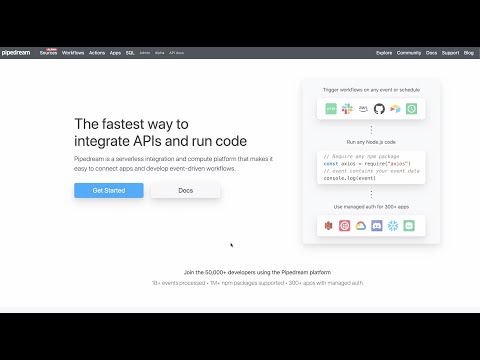What do you want to automate
with Databricks and PagerDuty?
Prompt, edit and deploy AI agents that connect to Databricks, PagerDuty and 2,800+ other apps in seconds.
Trusted by 1,000,000+ developers from startups to Fortune 500 companies
Popular Ways to Connect Databricks with PagerDuty#
Popular Databricks and PagerDuty Actions#
Cancel all active runs for a job. The runs are canceled asynchronously, so it doesn't prevent new runs from being started. See the documentation
Cancel a job run. The run is canceled asynchronously, so it may still be running when this request completes. See the documentation
Find the user on call for a specific schedule. See the docs here
Overview of Databricks#
The Databricks API allows you to interact programmatically with Databricks services, enabling you to manage clusters, jobs, notebooks, and other resources within Databricks environments. Through Pipedream, you can leverage these APIs to create powerful automations and integrate with other apps for enhanced data processing, transformation, and analytics workflows. This unlocks possibilities like automating cluster management, dynamically running jobs based on external triggers, and orchestrating complex data pipelines with ease.
Connect Databricks#
import { axios } from "@pipedream/platform"
export default defineComponent({
props: {
databricks: {
type: "app",
app: "databricks",
}
},
async run({steps, $}) {
return await axios($, {
url: `https://${this.databricks.$auth.domain}.cloud.databricks.com/api/2.0/preview/scim/v2/Me`,
headers: {
Authorization: `Bearer ${this.databricks.$auth.access_token}`,
},
})
},
})
Overview of PagerDuty#
The PagerDuty API offers a powerful interface to automate your digital operations management. By leveraging its capabilities on Pipedream, you can create workflows that respond to incidents, automate alerts, and synchronize incident data across various platforms. PagerDuty's API enables you to manage services, teams, and incidents, ensuring that your systems remain operational and that the right people are notified at the right time.
Connect PagerDuty#
import { axios } from "@pipedream/platform"
export default defineComponent({
props: {
pagerduty: {
type: "app",
app: "pagerduty",
}
},
async run({steps, $}) {
return await axios($, {
url: `https://api.pagerduty.com/users/me`,
headers: {
Authorization: `Bearer ${this.pagerduty.$auth.oauth_access_token}`,
"Accept": `application/vnd.pagerduty+json;version=2`,
},
})
},
})
Related Videos#
